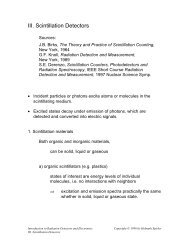Introduction to radiation-resistant semiconductor devices and circuits
Introduction to radiation-resistant semiconductor devices and circuits
Introduction to radiation-resistant semiconductor devices and circuits
You also want an ePaper? Increase the reach of your titles
YUMPU automatically turns print PDFs into web optimized ePapers that Google loves.
effects depend not only on the dose, but also on the dose rate. Fig. 2 also shows a<br />
thick field oxide, which serves <strong>to</strong> control the silicon surface charge adjacent <strong>to</strong> the<br />
FET <strong>and</strong> prevent parasitic channels <strong>to</strong> adjacent <strong>devices</strong>. The same positive charge<br />
buildup as in the gate oxide also occurs here, indeed it can be exacerbated because<br />
the field oxide is quite thick. For more details, see ref. (6), currently the<br />
authoritative text on ionization effects.<br />
In summary, ionization effects are determined by<br />
• Interface trapped charge<br />
• Oxide trapped charge<br />
• The mobility of trapped charge<br />
• The time <strong>and</strong> voltage dependence of charge states<br />
Although the primary <strong>radiation</strong> damage depends only on the absorbed ionizing<br />
energy, the resulting effects of this dose depend on the rate of ir<strong>radiation</strong>, the<br />
applied voltages <strong>and</strong> their time variation, the temperature, <strong>and</strong> the time variation of<br />
the <strong>radiation</strong> itself. Ionization damage manifests itself most clearly in MOS field<br />
effect transis<strong>to</strong>rs, so it will be discussed in more detail in that section.<br />
EFFECTS ON DEVICE CHARACTERISTICS<br />
Radiation Damage in Diodes<br />
Diode structures are basic components of more complex <strong>devices</strong>, for example<br />
bipolar transis<strong>to</strong>rs, junction FETs <strong>and</strong> integrated <strong>circuits</strong>. Since the properties of<br />
diode depletion regions are determined primarily by bulk properties, measurements<br />
on diodes will serve <strong>to</strong> illustrate the effects of displacement damage. Reverse<br />
biased diodes with large depletion depths are used as <strong>radiation</strong> detec<strong>to</strong>rs <strong>and</strong><br />
pho<strong>to</strong>diodes. Because of their large depletion depths, typically hundreds of<br />
microns, detec<strong>to</strong>r diodes are very sensitive <strong>to</strong> bulk damage <strong>and</strong> extensive work by<br />
the SSC/LHC community has produced many insights in<strong>to</strong> bulk <strong>radiation</strong> effects.<br />
Affected are the detec<strong>to</strong>r leakage current, the doping characteristics, <strong>and</strong> charge<br />
collection.<br />
A theoretical analysis from first principles is quite complex, due <strong>to</strong> the many<br />
phenomena involved. Take doping changes as an example. Si interstitials are quite<br />
active <strong>and</strong> displace either P donors or B accep<strong>to</strong>rs from substitutional sites <strong>and</strong><br />
render them electrically inactive. These interstitial dopants <strong>to</strong>gether with oxygen,<br />
7





